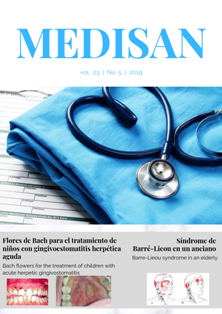Quality of medications prescription in stomatological emergencies visits
Keywords:
quality of prescription, medication prescription, professional competence, user's satisfaction.Abstract
Introduction: The prescription of medications is adjuvant in the surgical treatments during the stomatological clinical practice, it is characterized to be punctual and in most of the cases of short duration. In visits carried out to the stomatological emergencies departments from Santiago de Cuba municipality, it was observed that in the therapeutic medications applied dipirone, ibuprofeno and amoxicilin prescriptions prevailed.
Objective: To evaluate the quality of medications prescription in stomatological emergencies visits.
Methods: A study for the use of prescription-indication medications, with elements of the therapeutic scheme and of the factors that condition the prescription habits was carried out in 3 stomatological emergency services belonging to teaching and assistance institutions in Santiago de Cuba municipality, from January to December, 2017. The universe was constituted by 94 prescriptors and 282 users of medications. Dimensions such as structure, process and result were evaluated, for which criteria, indicators and standards were established.
Results: This study revealed scarce knowledge of the prescriptors regarding the main pharmacological aspects of the prescribed medications, inadequate performance during the prescription, dissatisfaction of them with the service that they provided and of the users regarding the received care.
Conclusions: In a general way, the quality of the medications prescription in the stomatological emergency visits was evaluated as inadequate.Downloads
References
2. García Milian AJ. Caracterización epidemiológica del consumo de medicamentos por la población adulta de Cuba: 2007-2010 [Tesis para optar el grado de Doctor en Ciencias de la Salud]. La Habana: Escuela Nacional de Salud Pública; 2011.
3. Organización Mundial de la Salud. Cómo desarrollar y aplicar una política farmacéutica nacional. 2 ed. Ginebra: OMS; 2002.
4. Holloway K, Green T. Comités de farmacoterapia: Guía práctica. Ginebra: OMS, Departamento de Medicamentos Esenciales y Política Farmacéutica; 2003.
5. Karaben VE, Ramírez LI, Rea AE, Morales SD. Análisis de la calidad de la prescripción de medicamentos en asociación a dosis fija usados en Odontología. Revista Facultad de Odontología. 2016 [citado 30/08/2018]; 9 (1): 42-9. Disponible en: http://revistas.unne.edu.ar/index.php/rfo/article/viewFile/1598/1366
6. Romero Benvenuto MR. Buenas Prácticas de prescripción en Odontología. Tendencias en Medicina. 2014; 22 (44): 127-30.
7. Agra Varela Y, García Boró S, Magrinya Rull P. Gerencia en calidad de los servicios de salud. En: Manual de Garantía de calidad en atención primaria. Madrid: Consejería de Salud; 1994. p. 29-34.
8. Costa S, Ballesteros J. Evolución de la fármaco-terapéutica hacia la aplicación racional de los medicamentos (continuación 2a parte). Actas Odontológicas. 2007; 4 (2): 32-9.
9. Cruz Barrios MA. Reacciones adversas del factor de transferencia y características de su prescripción. La Habana, 2001-2010 [Tesis para optar el grado de Doctor en Ciencias Médicas]. La Habana: Escuela Nacional de Salud Pública; 2014.
10. Orueta Sánchez R. Fuentes de información sobre medicamentos en internet. En: Arroyo Aniés MP, Baos Vicente V, Bayón Rueda A, Catalán Oliver C, Hernández Rodríguez MA, Oueta Sánchez R et al. Recomendaciones sobre el uso de los medicamentos. Guías de actualización. Barcelona: semFYC; 2012 [citado 29/06/2018]. Disponible en: https://www.semfyc.es/wp-content/uploads/2016/05/Recomendaciones_uso_medicamentos.pdf
11. Billikopf Encina G. Evaluación de desempeño. 2007 [citado 29/06/2018]. Disponible en: http://www.cnr.berkeley.edu/ucce50/agro-laboral/7libro/06s.htm
12. Cruz Barrios MA. Elementos para la prescripción racional de los medicamentos. En: Morón Rodríguez FJ, Levy Rodríguez M. Farmacología General. La Habana: ECIMED; 2002. p. 165-78.
13. Cabello E, Chirinos JL. Validación y aplicabilidad de encuestas SERVQUAL modificadas para medir la satisfacción de usuarios externos en servicios de salud. Rev Med Hered. 2012 [citado 24/07/2018]; 23 (2): 88-95. Disponible en: http://www.scielo.org.pe/scielo.php?script=sci_arttext&pid=S1018-130X2012000200003&lng=es
14. Santana de Freitas J, Bauer de Camargo Silva AE, Minamisava R, Queiroz Bezerra AL, Gomes de Sousa MR. Qualidade dos cuidados de enfermagem e satisfação do paciente atendido em um hospital de ensino. Rev Latino-Am Enfermagem. 2014 [citado 24/07/2018]; 22 (3): 454-60. Disponible en: http://www.redalyc.org/articulo.oa?id=281431353015
15. Reyes Fernández S, Paredes Solís S, Legorreta Soberanis J, Romero Castro NS, Flores Moreno M, Andersson N. Satisfacción de usuarios con los servicios de salud bucal y factores asociados en Acapulco, México. Rev Cubana Estomatol. 2015 [citado 29/06/2018]; 52 (3): 255-67. Disponible en: http://scielo.sld.cu/scielo.php?script=sci_arttext&pid=S0034-75072015000300003&lng=es
16. Muza R, Muza P. Satisfacción del paciente con tres especialidades dentales. Rev Chil Salud Pública. 2008; 12 (1): 12-7.
Published
How to Cite
Issue
Section
License
All the articles can be downloaded or read for free. The journal does not charge any amount of money to the authors for the reception, edition or the publication of the articles, making the whole process completely free. Medisan has no embargo period and it is published under the license of Creative Commons, International Non Commercial Recognition 4.0, which authorizes the copy, reproduction and the total or partial distribution of the articles in any format or platform, with the conditions of citing the source of information and not to be used for profitable purposes.





